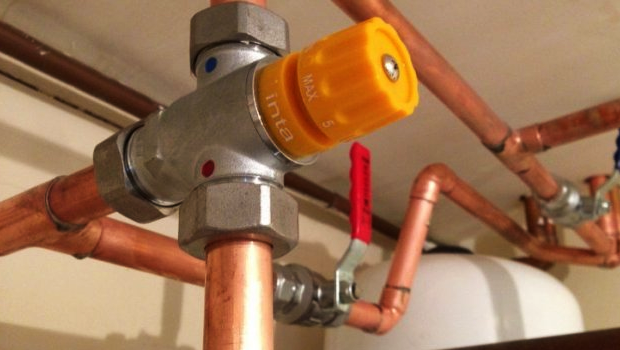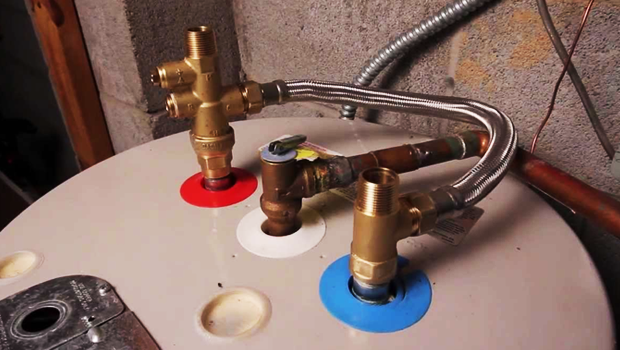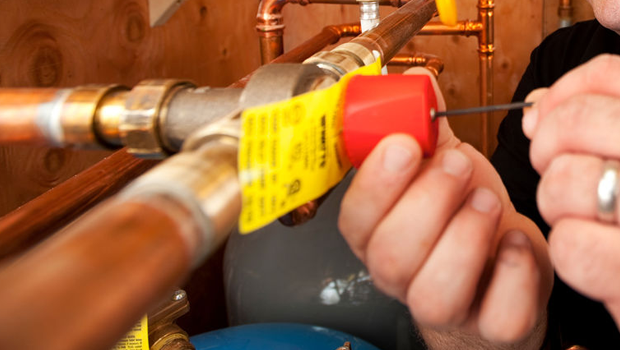Did you know, 80% of serious burns and scalds to young children occur in the home? According to Kidsafe Australia, the most common cause of burns in children were scalds at 57%. This is a worrying statistic, especially since most of these accidents are preventable. With the cooler months approaching, the best way to prevent and protect your children from scalding is by installing tempering valves.

What is a tempering valve?
A tempering valve is a valve designed to mix cold water with the hot water. They attach to the hot water system pipes. This then supplies water to sanitary fixtures such as the shower, bath and basin taps at a temperature of 50 degrees or below, reducing the chances of serious scalding.
The water in a hot water storage heater must be heated and stored above 60 degrees. This is to kill bacteria such as legionnaires disease and prevent it from developing in the water. This being the case, 60 degrees is a dangerous temperature for the tender skin of our precious kids.
Different types of tempering valves
The type of tempering valve needed will depend on the type of hot water system in use. There are blue, green, orange and black tempering valves for electric, gas, solar or large hot water systems.
- Blue – A blue tempering valve is used for an electric hot water system and is the most common.
- Green – A green tempering valve is used for gas hot water systems.
- Orange – An orange tempering valve is used for solar hot water systems.
- Black – A black tempering valve is used for larger hot water systems, usually for commercial use.
The regulations
As of 1st July 2012, Fair Trading have now made it compulsory for households in New South Wales to have a tempering valve installed in all new homes, renovations or hot water heater replacements where the water is heated above 50 degrees. They must be installed by a licensed plumber and then replaced every five years.

How to check a tempering valve is working
It is important your tempering valve is always working to prevent burns and scalds. If you suspect your tempering valve isn’t working, call your plumber and have them come out to inspect it. Ensure you don’t use the hot water until they can come out.
You’ll know your tempering valve isn’t working because either:
- The temperature isn’t ranging from hot to cold
- There is no hot water in your bathroom. (But it is present in your kitchen and laundry – where you won’t have a tempering valve installed).
Remember, as mentioned above, the lifespan of a tempering valve is 5 years.
Maintenance of tempering valves
To prevent problems with a tempering valve, they should be maintained regularly by a professional plumber.
Your plumber will:
- Inspect the tempering valve to check for any abnormalities or problems.
- Prevent debris, such as leaves and dirt, entering the hot water system or filter.
- Check the filter isn’t blocked. The filter stops debris entering the hot water system.

Mixer taps
With mixer taps now being the fashion in bathrooms and kitchens, it is now easier for young children to turn the tap on and risk a serious scalding.
I experienced a scary situation recently with my little boy who was one and a half at the time. We had just moved into a house that had a gas boosted solar hot water system. I had noticed that the system had not been installed with a tempering valve.
I told myself that installing a tempering valve is the next job around the house that has to be ticked off the to do list. A week or so later while working in the kitchen, without noticing my little guy had dragged his stool over to the sink and managed to turn the kitchen mixer tap on. Hearing it turn on I jumped over and slammed it off as quick as I could and it dawned on me how easy it now is for kids to turn on a lever handled mixer tap. This in turn exposes them to the serious risk of scalding if a tempering valve is not installed.
When taps were just the standard turn the handle style with a tap washer, a young child would have struggled to turn them on, but as I witnessed with my one and a half year old, even a baby can turn on a modern mixer tap.
Hot water safety
A child can suffer a scald in a very short amount of time, proving the importance of hot water safety. Below is a table showing the time it takes to suffer a burn based on temperature as well as where these high temperatures can occur:
| Liquid type | Temperature C | Time |
|---|---|---|
| Boiling water from a kettle | 100 ºC | Under 1 second |
| Cup of hot tea/coffee | 70 – 95 ºC | Under 1 sec |
| Hot water from the tap | 60 ºC | 1 second |
| Hot water from a kettle 5-10minutes after boiling | 55 ºC | 10 seconds |
| Hot water from a tap with a tempering valve | 50 ºC | 5 minutes |
To ensure you keep your home hot water safe, follow these easy tips:
- Have your hot water system maintained and inspected by a professional plumber once a year to make sure everything is working as it should be.
- Ensure the hot water temperature is coming into your bathrooms at no more than 50 degrees celsius.
- Supervise young children around hot water systems in the home.
- Always run the bath yourself for your children, making sure to always use cold water first and turn it off last.
- Install attachments on your taps so your children cannot turn them on.
- Ensure everyone in the home knows the 000 emergency number.
- Keep the kettle away from the kitchen bench edge.
- Turn pots and pans handles away from children’s hands when cooking.
- Use a safety gate or barrier at the entrance to the kitchen.
- Never consume hot drinks or hot food when holding a child.
- Keep a first aid kit in your home at an easy to reach place.
Children and hot water don’t mix well so it’s imperative you get your home “hot water safe” and protect your children from scalding today.


